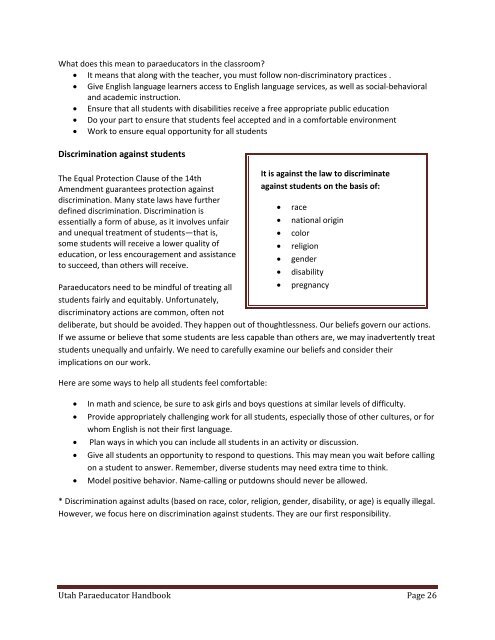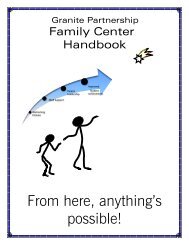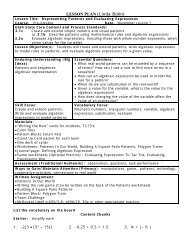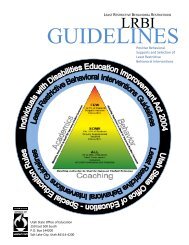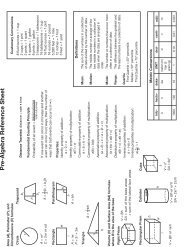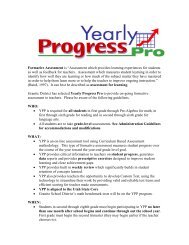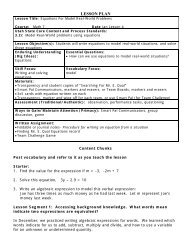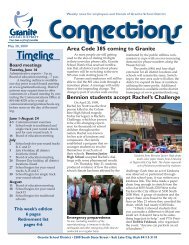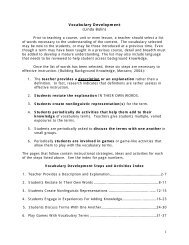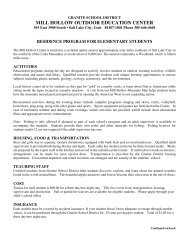Utah Special Education Paraeducator Handbook - Granite School ...
Utah Special Education Paraeducator Handbook - Granite School ...
Utah Special Education Paraeducator Handbook - Granite School ...
Create successful ePaper yourself
Turn your PDF publications into a flip-book with our unique Google optimized e-Paper software.
What does this mean to paraeducators in the classroom?<br />
It means that along with the teacher, you must follow non-discriminatory practices .<br />
Give English language learners access to English language services, as well as social-behavioral<br />
and academic instruction.<br />
Ensure that all students with disabilities receive a free appropriate public education<br />
Do your part to ensure that students feel accepted and in a comfortable environment<br />
Work to ensure equal opportunity for all students<br />
Discrimination against students<br />
The Equal Protection Clause of the 14th<br />
Amendment guarantees protection against<br />
discrimination. Many state laws have further<br />
defined discrimination. Discrimination is<br />
essentially a form of abuse, as it involves unfair<br />
and unequal treatment of students—that is,<br />
some students will receive a lower quality of<br />
education, or less encouragement and assistance<br />
to succeed, than others will receive.<br />
<strong>Paraeducator</strong>s need to be mindful of treating all<br />
students fairly and equitably. Unfortunately,<br />
discriminatory actions are common, often not<br />
<br />
<br />
pregnancy<br />
age<br />
deliberate, but should be avoided. They happen out of thoughtlessness. Our beliefs govern our actions.<br />
If we assume or believe that some students are less capable than others are, we may inadvertently treat<br />
students unequally and unfairly. We need to carefully examine our beliefs and consider their<br />
implications on our work.<br />
Here are some ways to help all students feel comfortable:<br />
It is against the law to discriminate<br />
against students on the basis of:<br />
<br />
<br />
<br />
<br />
<br />
<br />
race<br />
national origin<br />
color<br />
religion<br />
gender<br />
disability<br />
<br />
<br />
<br />
<br />
<br />
In math and science, be sure to ask girls and boys questions at similar levels of difficulty.<br />
Provide appropriately challenging work for all students, especially those of other cultures, or for<br />
whom English is not their first language.<br />
Plan ways in which you can include all students in an activity or discussion.<br />
Give all students an opportunity to respond to questions. This may mean you wait before calling<br />
on a student to answer. Remember, diverse students may need extra time to think.<br />
Model positive behavior. Name-calling or putdowns should never be allowed.<br />
* Discrimination against adults (based on race, color, religion, gender, disability, or age) is equally illegal.<br />
However, we focus here on discrimination against students. They are our first responsibility.<br />
<strong>Utah</strong> <strong>Paraeducator</strong> <strong>Handbook</strong> Page 26


